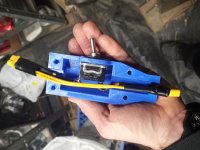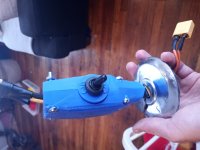harrisonpatm
10 kW
- Joined
- Aug 8, 2022
- Messages
- 824
My 24S LiFePO4 e-moto uses an XT60 port for charging. I had a learning curve trying to avoid sparking when connecting the charger. First I got those anti-spark XT connectors; they failed immediately. I looked into a couple of anti-spark circuits that I could buy, but even 20-40 USD seemed a bit expensive to me. So what I decided to do was make a simple XT60 M to F adapter with a toggle switch on the positive line. Switch off, plug in the charger, switch on. Therefore, I didn't make an anti-spark anything, all I did was move the spark to a toggle switch. That way, I can purchase an over-specced switch for my needs that can handle the spark, and even if it eventually fails, all I have to replace is a cheap switch. Works for me. I wrapped it up in electrical tape.
Then I got a 3d printer last month and have been learning about it, so I made a sort of charging handle for my contraption. I thought I'd share with the forum, I bet there's a few members here that use XT60 ports for charging and might enjoy a nicely-shaped handle for charging their EV. Made a simple wall-mount holster for it, to kind of replicate the gas pump experience. Please excuse my messy print, I'm still learning the hobby and figuring out my settings. Would love input on the design.
https://www.printables.com/model/349398-xt60-switch-handle-for-charging


Then I got a 3d printer last month and have been learning about it, so I made a sort of charging handle for my contraption. I thought I'd share with the forum, I bet there's a few members here that use XT60 ports for charging and might enjoy a nicely-shaped handle for charging their EV. Made a simple wall-mount holster for it, to kind of replicate the gas pump experience. Please excuse my messy print, I'm still learning the hobby and figuring out my settings. Would love input on the design.
https://www.printables.com/model/349398-xt60-switch-handle-for-charging



